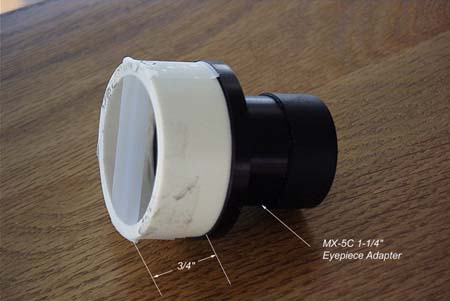 |
This
photo shows a ring I cut from a piece of plastic pipe attached to the MX-5C
1-1/4" Eyepiece Adapter.
Just about any material including paper could be used. The idea is to place the strip of tape about the same distance from the scope objective as the surface of the CCD will be. The 3/4" dimension is the approximate distance from the front edge of the MX-5C to the surface of the CCD. You will need to modify this value if you have a different type of CCD Camera. |
 |
This
photo shows one optical configuration. The focus ring is mounted
to the scope instead of the MX-5C.
The key point to remember is that the front of the focus ring (the side away from the strip of tape) needs to be positioned at the same point as the front of the MX-5C will be when it is attached to the scope. Point the scope at a bright star (magnitude 1 or brighter), the moon, a bright planet, or bright terrestrial object. Then adjust the scopes focus knob until you see an image on the strip of tape. NEVER POINT THE SCOPE AT THE SUN. Replace the focus ring with the MX-5C and point the scope at star. You should be able to see the star well enough to precisely focus it.
|
 |
This
aid is just a paper scale taped to the focus knob. I've noticed that
my different optical configurations required moving the focus over large
differences. About 11 turns of the knob. With the scale, I
just count the number of turns to move from one position to another.
There are two potential problems with this approach. 1. You need to remember what optical arrangement you last used the scope in. 2. You need to be careful not to loose count. But it does work and it makes changing optical arrangements much easier. For example, when switching from using the focal reduce to not using it. |
|
|
|